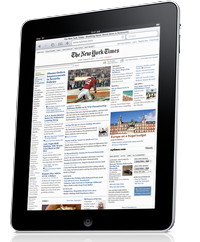Tech
Yes, the iPad is the 'wild west' of mobile UI
In a screed titled iPad Usability: First Findings From User Testing, user interface guru Jakob Nielsen offers up a long list of interface problems with the iPad. The "problem" is that the iPad platform is so fresh, and Apple is being surprisingly open to interface experiments, that developers are all over the map (or the touch screen) with interaction ideas.


The iPad etched-screen aesthetic does look good. No visual distractions or nerdy buttons. The penalty for this beauty is the re-emergence of a usability problem we haven't seen since the mid-1990s: Users don't know where they can click. For the last 15 years of Web usability research, the main problems have been that users don't know where to go or which option to choose — not that they don't even know which options exist. With iPad UIs, we're back to this square one.This situation on the iPad is the opposite of the Mac OS X desktop user experience, which has evolved for decades, incorporating elements from the NeXT interface and the Apple Macintosh. There have been times in the 1990s, when Apple was decried as being too controlling about its interface. I agree with a number of Nielsen's criticisms. It's hard to know in programs where there's more "stuff" off screen. Only with an experimental swipe are the extra text or images revealed. In addition, some iPad versions are needlessly dumbed down to smartphone experience. I find the standard desktop browser interfaces for some websites are perfectly usable on the iPad, but the mobile versions, designed for a phone-sized display, seem stripped down on the iPad. For example, the standard Facebook site running on Safari is being perfectly usable on the iPad. In a post a while back, I pointed to some issues that Apple was juggling in the UI department. Apple offers developers UI guidelines for Mac, iPhone and iPad. Check Out: First looks at Apple's iPad user experience guidelines In the post, I mentioned that according to Apple, iPad apps should have a clean, focused look without a lot of buttons or controls.
De-emphasize User Interface Controls Help people focus on the content by designing your application UI as a subtle frame for the information they’re interested in. Downplay application controls by minimizing their number and prominence. Consider creating custom controls that subtly integrate with your application’s graphical style. In this way, controls are discoverable, but not too conspicuous.Perhaps in some instances, the controls are too de-emphasized. And since there are almost no common gestures or signs on the platform, users have to figure out the values of each app, as Nielsen mentions. Here are Nielsen's suggestions:
•Add dimensionality and better define individual interactive areas to increase discoverability through perceived affordances of what users can do where. •To achieve these interactive benefits, loosen up the etched-glass aesthetic. Going beyond the flatland of iPad's first-generation apps might create slightly less attractive screens, but designers can retain most of the good looks by making the GUI cues more subtle than the heavy-handed visuals used in the Macintosh-to-Windows-7 progression of GUI styles. •Abandon the hope of value-add through weirdness. Better to use consistent interaction techniques that empower users to focus on your content instead of wondering how to get it. •Support standard navigation, including a Back feature, search, clickable headlines, and a homepage for most apps.We will see how long Apple takes to "suggest" some UI rules to iPad developers. Perhaps we will hear more details at the upcoming WWDC in June.